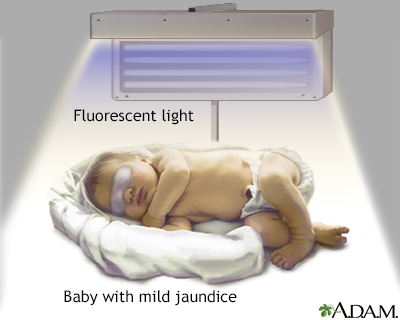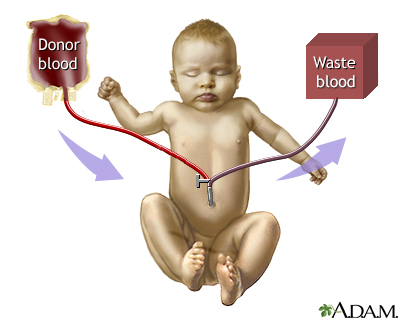
The following exams, tests, and procedures are recommended for #AGEGROUPLOWER#.#FEMALETEXT#
Select a link from the list below to learn how and why each test is performed, as well how to prepare for it.
 All rights reserved.
All rights reserved.
A.D.A.M. content is best viewed in IE9 or above, Firefox and Google Chrome browsers.




Using bili lights is a therapeutic procedure performed on newborn or premature infants to reduce elevated levels of bilirubin. If blood levels of bilirubin become too high, the bilirubin begins to dissolve in the body tissues, producing the characteristic yellow eyes and skin of jaundice. Bilirubin also has an affinity for brain tissue, where it can accumulate and cause permanent brain damage.
Using bili lights is a therapeutic procedure performed on newborn or premature infants to reduce elevated levels of bilirubin. If blood levels of bil...
Less frequently, when neonatal jaundice is more severe, and fluorescent light therapy is unable to break down all circulating bilirubin, exchange transfusion is often used. High levels of bilirubin in the blood can lead to brain damage and other serious problems. In these cases, exchange transfusion is a life-saving procedure designed to counteract the effects of serious jaundice, infection, or toxicity. The procedure involves the staged removal of the infant's blood and replacement with fresh donor blood or plasma. Guidelines for an exchange transfusion include hemolytic disease of the newborn (Rh disease), life-threatening infection, severe disturbances in body chemistry, toxic effects of drugs, polycythemia.
Less frequently, when neonatal jaundice is more severe, and fluorescent light therapy is unable to break down all circulating bilirubin, exchange tra...
The infant is laid on their back, usually under a radiant warmer. The umbilical vein is catheterized with a fluid-filled catheter. The catheter is connected to an exchange transfusion set, incorporating lines to and from a waste container and a pack of donor blood. These are connected by means of a four-way stopcock, to which is also attached the syringe used to remove and replenish the infant's blood. The exchange transfusion now goes ahead in cycles, each of a few minutes duration. Slowly the infant's blood is withdrawn, and the fresh, pre-warmed blood or plasma is injected. After the exchange transfusion, an umbilical catheter may be left in place in case the procedure needs to be repeated within a few hours.
The infant is laid on their back, usually under a radiant warmer. The umbilical vein is catheterized with a fluid-filled catheter. The catheter is co...
Review Date: 11/6/2023
Reviewed By: Neil K. Kaneshiro, MD, MHA, Clinical Professor of Pediatrics, University of Washington School of Medicine, Seattle, WA. Also reviewed by David C. Dugdale, MD, Medical Director, Brenda Conaway, Editorial Director, and the A.D.A.M. Editorial team.